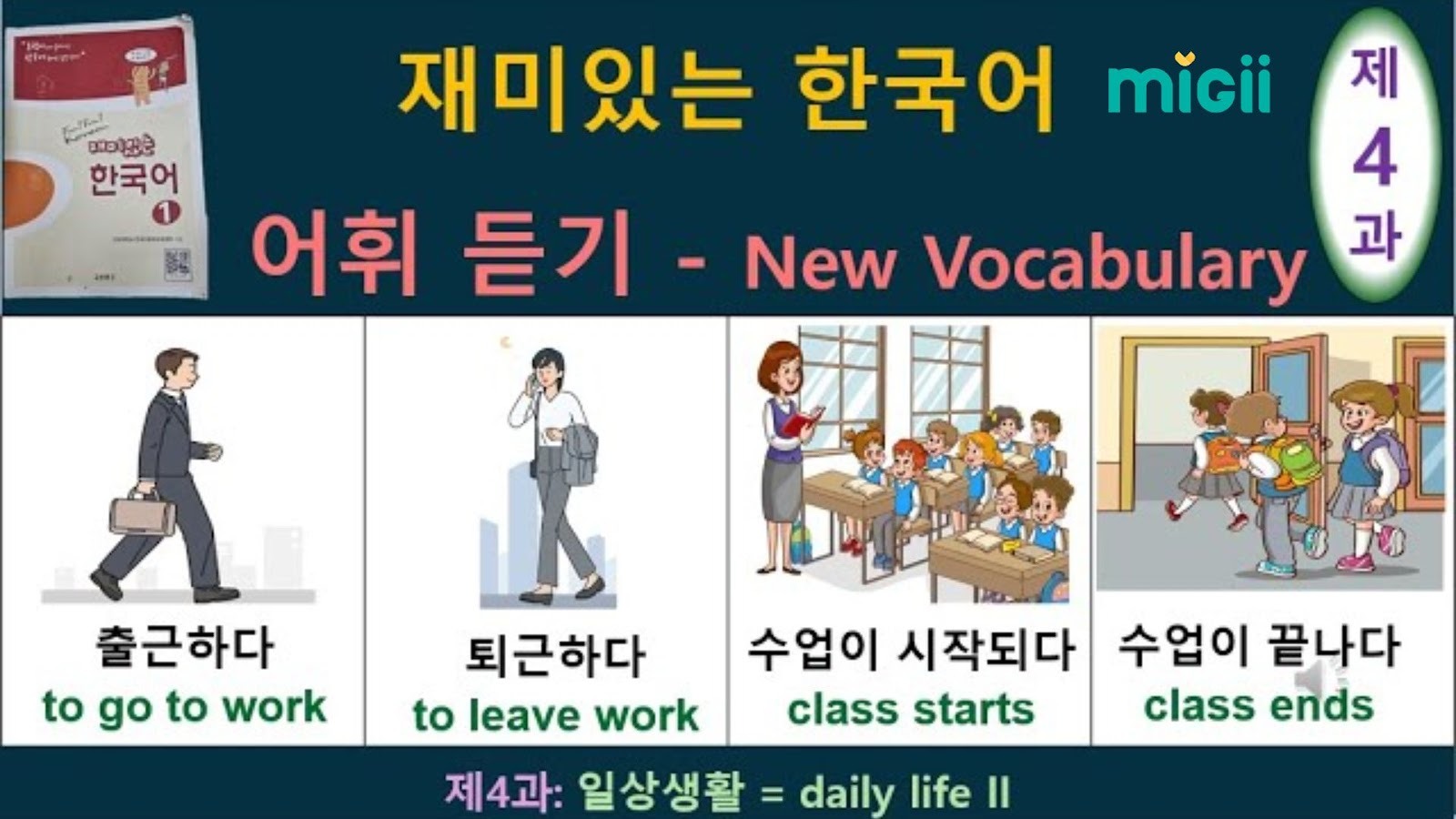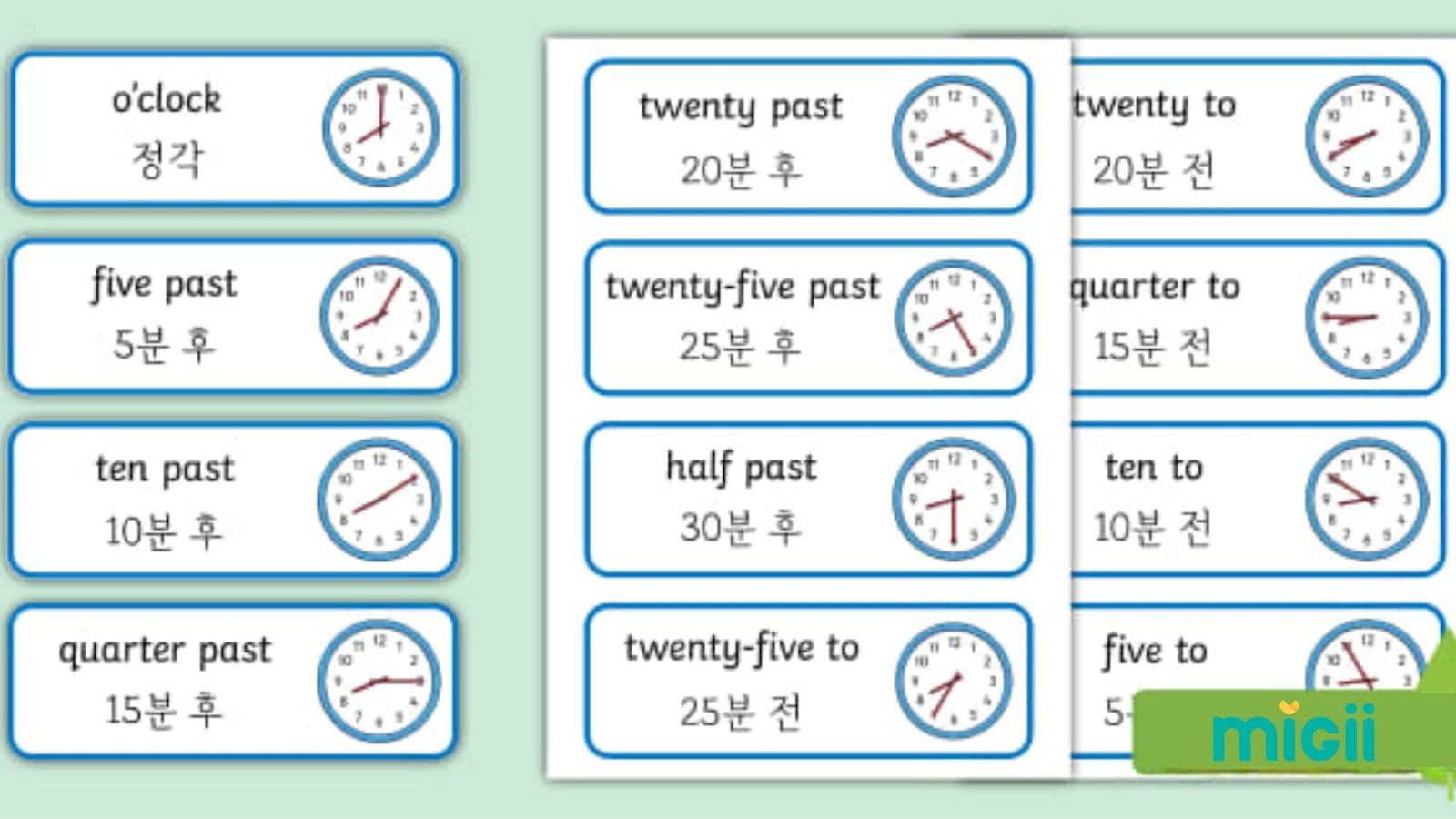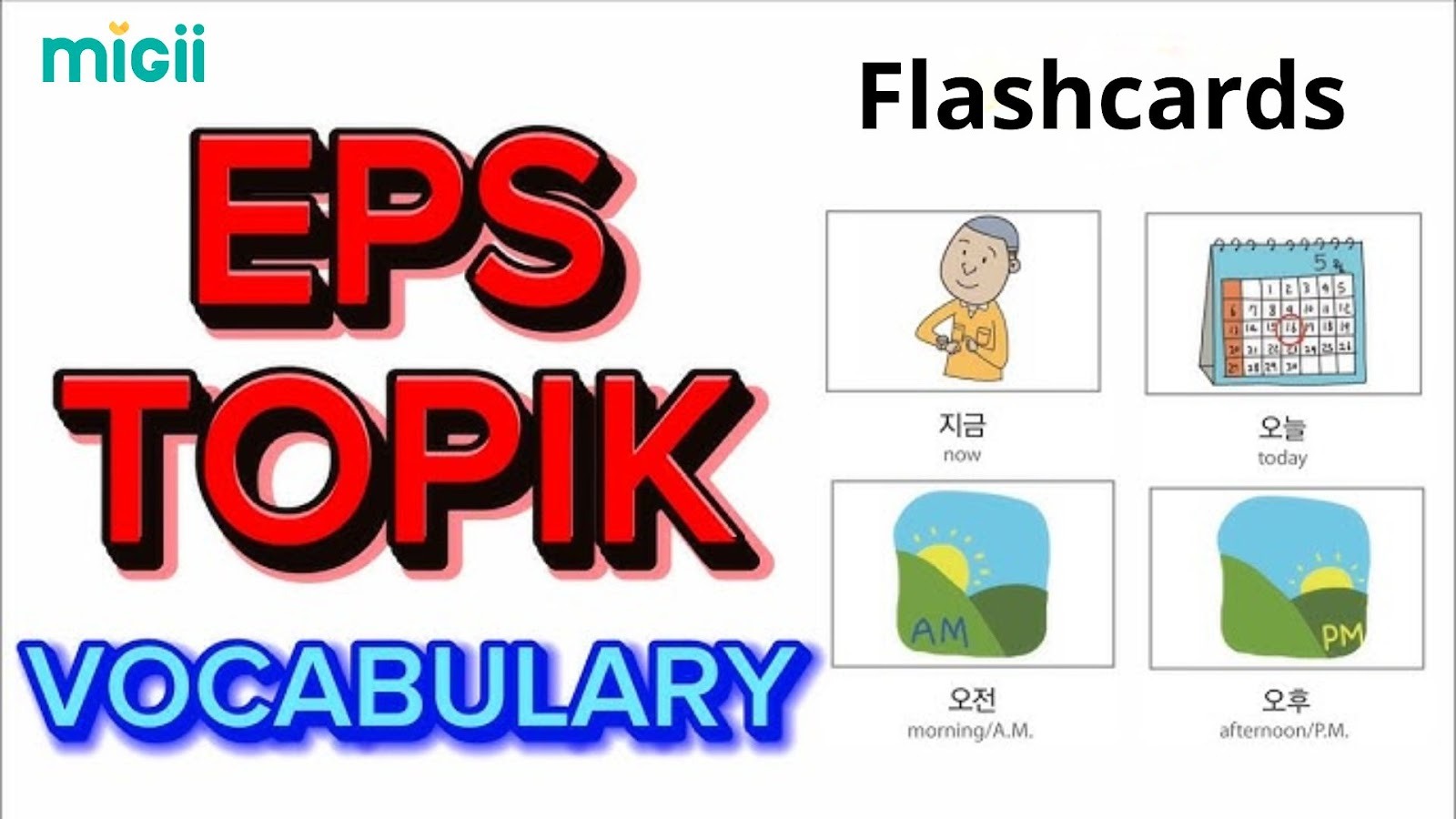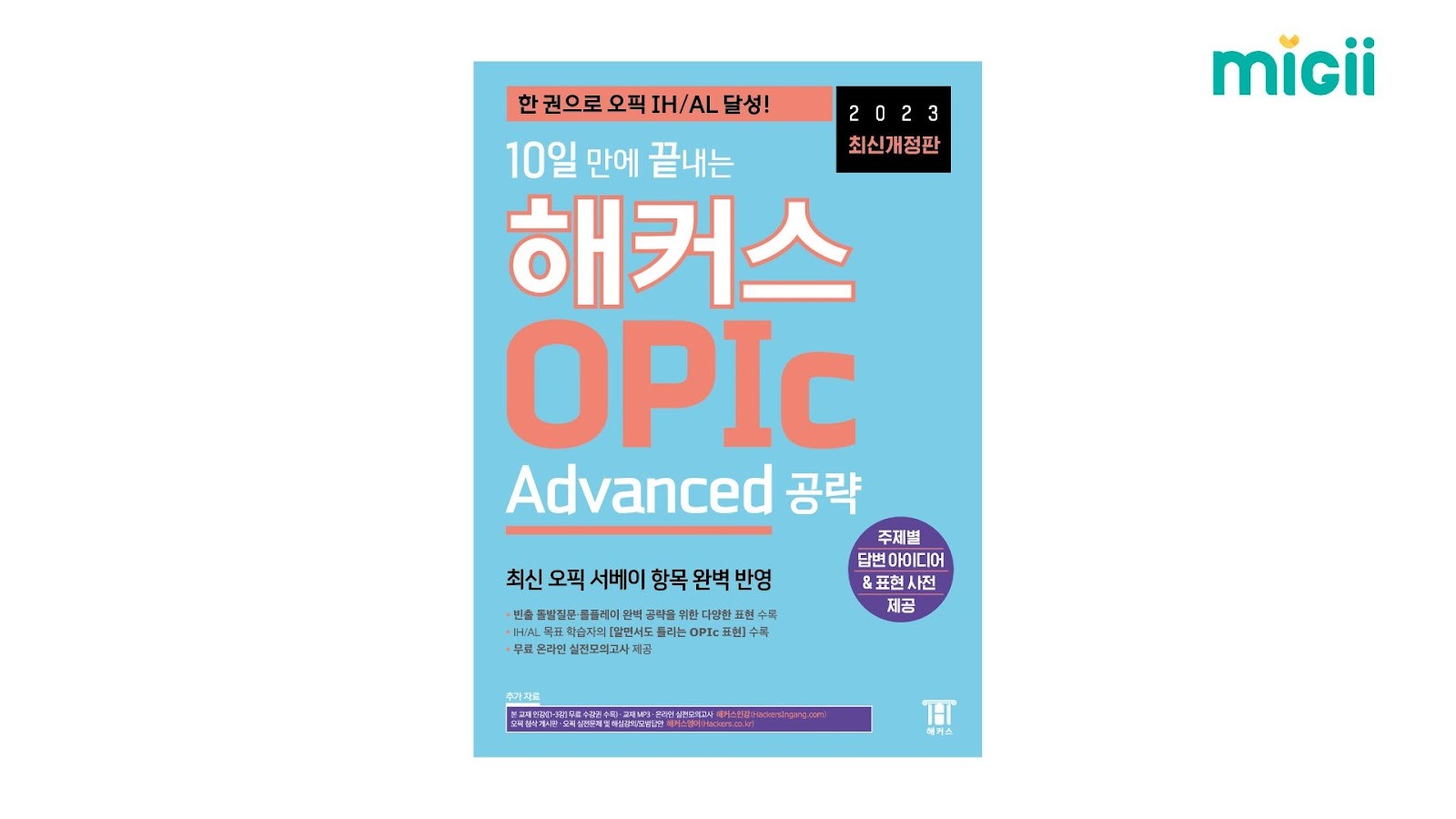The EPS TOPIK Vocabulary is a curated list of essential Korean words specifically designed to help workers and learners prepare for the EPS TOPIK exam. It covers practical vocabulary used in daily life, workplace communication, and common test scenarios. Studying this vocabulary systematically can significantly improve reading, listening, and overall language comprehension for the exam.

Introduction to EPS TOPIK Vocabulary
The EPS TOPIK (Employment Permit System Test of Proficiency in Korean) is a specialized language exam designed for foreign workers who wish to work legally in South Korea. Unlike general Korean language tests, EPS TOPIK focuses on practical language skills required in real workplace environments, which makes vocabulary an essential component of success. A strong command of vocabulary not only helps candidates understand exam questions more accurately but also ensures they can communicate effectively with colleagues, supervisors, and clients in everyday work situations.
The EPS TOPIK vocabulary set has several distinctive features that differentiate it from general Korean learning resources. It includes words and phrases commonly used in the workplace, safety warnings, occupational safety and health terms, machine operation instructions, administrative procedures, and other work-related contexts. This specificity is vital because workers often encounter scenarios in which using the correct terminology can prevent misunderstandings or even accidents.

EPS TOPIK Vocabulary
Learning EPS TOPIK vocabulary by topic is highly recommended because it allows learners to organize their study systematically and retain words more effectively. For example, grouping vocabulary into categories such as workplace tasks, safety signs, labor regulations, daily communication, and emergency procedures helps learners not only remember the words but also understand how to apply them in context.
Furthermore, having access to complete vocabulary lists, ideally with downloadable PDF files, can significantly enhance the learning process. Such resources allow learners to review, test themselves, and reinforce knowledge anytime, anywhere, which is especially helpful for busy workers preparing for the exam. By approaching EPS TOPIK vocabulary in a structured, thematic manner, candidates can build confidence, improve efficiency, and achieve better results on the test while also preparing for real-life workplace challenges in South Korea.
Overview of EPS TOPIK Vocabulary List
The EPS TOPIK vocabulary consists of approximately 1,200–1,500 core Korean words that are essential for passing the exam. These words were carefully selected by HRD Korea to cover practical language used in workplace settings, safety instructions, administrative tasks, and daily life communication. While the exact number can vary slightly depending on the source, mastering this set of vocabulary ensures that candidates are well-prepared for both the Listening and Reading sections of the exam.
How HRD Korea Allocates Vocabulary in Listening and Reading
HRD Korea organizes the vocabulary in a way that aligns with the exam structure. The table below provides a general distribution of vocabulary usage across the two main test components:
|
Test Section |
Vocabulary Focus |
Approximate Proportion |
|
Listening |
Workplace instructions, safety warnings, conversations with supervisors, daily tasks |
60% |
|
Reading |
Notices, forms, manuals, safety signs, procedural texts |
40% |
This allocation shows that candidates should pay particular attention to listening comprehension in workplace contexts, as most vocabulary usage appears there, but reading skills are equally important for understanding written instructions and official documents.
Most Frequently Appearing Vocabulary Groups
Some of the vocabulary groups that appear most frequently in the EPS TOPIK exam include:
- Workplace & Job Tasks – verbs and nouns describing daily work routines and equipment usage.
- Safety & Warning Signs – phrases related to labor safety, emergency procedures, and hazard signs.
- Administrative & Legal Terms – words used in forms, contracts, HR documents, and official notices.
- Numbers, Dates & Measurements – counting, time, weight, and dimensions relevant to tasks.
- Daily Communication – greetings, requests, and polite expressions used between colleagues.
Focusing on these groups helps learners prioritize high-frequency words and improve both exam performance and practical workplace communication.
EPS TOPIK Vocabulary List PDF
For convenience, learners can download ready-made EPS TOPIK vocabulary lists in PDF format, which often include grouped words, example sentences, and sometimes quizzes. Alternatively, you can create a personalized PDF by compiling your own word lists using tools like Google Docs, Notion, or Excel, then exporting them as PDF. Having a PDF file allows for offline study, quick revision, and consistent practice, which is especially useful for busy candidates preparing for the exam.
Download EPS TOPIK Vocabulary List PDF:
By systematically learning the EPS TOPIK vocabulary and using PDF resources, candidates can efficiently master essential words, improve comprehension, and gain confidence for the test.
Important Vocabulary Groups in EPS TOPIK
The EPS TOPIK exam requires candidates to master specific groups of vocabulary that are frequently used in daily life, workplace settings, and practical communication scenarios. These core vocabulary groups can be broadly categorized as follows:
Daily Life Vocabulary (생활)
This category covers words related to family, housing, food, and shopping. These words are essential because they frequently appear in basic conversations and everyday interactions. Examples include common nouns for household items, meals, and expressions used when shopping or discussing personal life. Mastering this set helps candidates understand routine dialogues and communicate effectively in casual or semi-formal settings.
Examples:
- Family (가족): 어머니 (mother), 아버지 (father), 형 (older brother), 동생 (younger sibling)
- Housing (집 / 가구): 방 (room), 부엌 (kitchen), 침대 (bed), 의자 (chair)
- Food (음식): 밥 (rice/meal), 김치 (kimchi), 물 (water), 빵 (bread)
- Shopping / Daily Life Expressions (쇼핑 / 생활 표현): 얼마예요? (How much is it?), 사고 싶어요 (I want to buy it), 감사합니다 (Thank you), 안녕하세요 (Hello)
Mastering this set helps candidates understand routine dialogues and communicate effectively in casual or semi-formal settings, such as talking with neighbors, ordering food, or shopping in stores.

Daily Life Vocabulary (생활)
Work and Factory Vocabulary (작업 / 공장)
Vocabulary in this group focuses on machinery, tools, and equipment used in industrial or factory environments. Important verbs include operational actions such as turn on, turn off, assemble, and install. Additionally, candidates should be familiar with warning and caution terms that often appear in workplaces, ensuring safe and correct handling of machines and processes. This vocabulary is critical for passing exam questions set in realistic work scenarios.
Examples of Work and Factory Vocabulary:
|
Category |
Korean |
English Translation |
Notes / Usage Example |
|
Machinery / Equipment |
기계 |
Machine |
기계를 켜다 (Turn on the machine) |
|
장비 |
Equipment |
보호 장비 착용 (Wear protective gear) |
|
|
도구 |
Tool |
도구를 사용하다 (Use the tool) |
|
|
Operational Verbs |
켜다 |
Turn on |
기계를 켜다 (Turn on the machine) |
|
끄다 |
Turn off |
조명을 끄다 (Turn off the light) |
|
|
조립하다 |
Assemble |
부품을 조립하다 (Assemble parts) |
|
|
설치하다 |
Install |
기계를 설치하다 (Install the machine) |
|
|
Warning / Caution Terms |
주의 |
Caution |
주의! 미끄러움 (Caution! Slippery) |
|
위험 |
Danger |
위험 구역 출입금지 (No entry – danger zone) |
|
|
정지 |
Stop |
비상 정지 버튼 (Emergency stop button) |
This structured approach helps learners recognize key workplace terms and apply them in practical scenarios, which is essential both for the EPS TOPIK exam and actual work situations in Korea.
Occupational Safety Vocabulary (안전 / 주의)
Safety-related vocabulary is a vital component of EPS TOPIK. Candidates must understand the meaning of common warning signs such as 조심 (Caution), 출입금지 (No Entry), 위험 (Danger). Familiarity with personal protective equipment (PPE) terms is also required to comprehend safety instructions and comply with workplace regulations. Learning this vocabulary reduces the risk of miscommunication and enhances understanding of safety protocols.
Examples of Occupational Safety Vocabulary:
|
Category |
Korean |
English Translation |
Notes / Usage Example |
|
Warning Signs |
조심 |
Caution |
조심! 바닥이 미끄럽다 (Caution! The floor is slippery) |
|
출입금지 |
No Entry |
출입금지 구역 (No entry zone) |
|
|
위험 |
Danger |
위험! 고전압 (Danger! High voltage) |
|
|
Emergency / Safety Actions |
정지 |
Stop |
비상 정지 버튼 (Emergency stop button) |
|
대피 |
Evacuate |
화재 시 대피하세요 (Evacuate in case of fire) |
|
|
Protective Equipment |
안전모 |
Safety helmet |
안전모 착용 필수 (Wearing a helmet is mandatory) |
|
안전화 |
Safety shoes |
안전화 착용 필수 (Wear safety shoes) |
|
|
보호장갑 |
Protective gloves |
보호장갑 착용 (Wear protective gloves) |
|
|
안전벨트 |
Safety harness |
안전벨트를 착용하다 (Wear a safety harness) |
By familiarizing themselves with these terms, learners can recognize and follow safety protocols, both for the EPS TOPIK exam and in real Korean workplaces. Understanding and using safety vocabulary accurately is essential for effective communication, accident prevention, and compliance with workplace regulations.
Time, Numbers, and Measurement Units Vocabulary (시간 / 숫자 / 단위)
This category includes native Korean numbers, Sino-Korean numbers, and measurement units used to indicate production quantity, weight, and dimensions. Candidates need to understand both types of numbers, as they are applied differently depending on context. Mastery of this vocabulary allows for accurate comprehension of schedules, reports, instructions, and data in both the exam and real work environments.
Examples:
- Native Korean numbers: 하나 (one), 둘 (two), 셋 (three). For instance, 사과 세 개 means “three apples.”
- Sino-Korean numbers: 일 (one), 이 (two), 삼 (three). For example, 생산량 100개 means “production quantity: 100 units.”
- Time expressions: 시 (hour), 분 (minute). Example: 9시 30분 회의 means “meeting at 9:30.”
- Weight: 킬로그램 (kg). Example: 물 5kg means “5 kilograms of water.”
- Length / Dimensions: 센티미터 (cm). Example: 길이 50cm means “length: 50 cm.”

Time, Numbers, and Measurement Units Vocabulary
Understanding these numbers and units is crucial because misreading them can lead to mistakes in production, scheduling, or communication. Candidates are encouraged to practice using both native and Sino-Korean numbers in different contexts to ensure accurate comprehension and application.
Practical Workplace Situations Vocabulary
This group encompasses vocabulary needed for real-life work interactions in Korea, such as communicating with supervisors, requesting leave, reporting incidents, and clocking in or out. These words and phrases are directly related to workplace communication and help candidates navigate professional environments safely and efficiently.
By focusing on these core vocabulary groups, learners can systematically prepare for the EPS TOPIK exam while also gaining practical language skills necessary for working in Korea. Organizing study by topics allows candidates to memorize efficiently, apply knowledge in context, and improve both exam performance and workplace communication.
600+ EPS TOPIK Vocabulary List by Topic
The EPS TOPIK exam requires candidates to master a wide range of vocabulary that appears in daily life, workplace, safety, and production contexts. Organizing vocabulary by topic helps learners memorize efficiently, understand context, and apply words correctly in both the exam and real-life situations. Below is a breakdown of the core vocabulary groups, along with explanations and the purpose of studying each set.
Basic Vocabulary – 150 words
The basic vocabulary category includes the most common words and expressions used in everyday communication. This group covers greetings, numbers, common verbs, and simple nouns that appear frequently in both the Listening and Reading sections of the EPS TOPIK exam. Mastering this set allows learners to handle simple conversations, understand instructions, and navigate daily situations in Korea with confidence.
|
Korean |
English Translation |
Example / Usage |
|
안녕하세요 |
Hello |
안녕하세요! (Hello!) |
|
감사합니다 |
Thank you |
감사합니다. (Thank you.) |
|
먹다 |
To eat |
밥을 먹다. (Eat rice.) |
|
가다 |
To go |
학교에 가다. (Go to school.) |
|
오다 |
To come |
집에 오다. (Come home.) |
|
하나 |
One |
사과 하나. (One apple.) |
|
둘 |
Two |
사과 둘. (Two apples.) |
|
셋 |
Three |
사과 셋. (Three apples.) |
|
물 |
Water |
물 한 컵. (A glass of water.) |
Work Vocabulary – 200 words
The work vocabulary group focuses on machinery, tools, equipment, and workplace actions. Candidates should learn important operational verbs such as turn on, turn off, assemble, and install, as well as nouns related to factory tools and components. Understanding this vocabulary is essential for exam questions based on real work scenarios and for safely performing tasks in industrial environments.
|
Korean |
English Translation |
Example / Usage |
|
기계 |
Machine |
기계를 켜다. (Turn on the machine) |
|
장비 |
Equipment |
장비를 점검하다. (Inspect equipment) |
|
도구 |
Tool |
도구를 사용하다. (Use the tool) |
|
켜다 |
Turn on |
기계를 켜다. (Turn on the machine) |
|
끄다 |
Turn off |
조명을 끄다. (Turn off the light) |
|
조립하다 |
Assemble |
부품을 조립하다. (Assemble parts) |
|
설치하다 |
Install |
기계를 설치하다. (Install the machine) |
|
부품 |
Part / Component |
부품을 교체하다. (Replace the part) |
|
작업장 |
Worksite / Factory floor |
작업장에서 일하다. (Work in the factory) |
|
운반하다 |
Carry / Transport |
물건을 운반하다. (Transport items) |
Safety Vocabulary – 80 words
The safety vocabulary category includes terms related to personal protective equipment, warning signs, and emergency actions. Candidates must know the meaning of common signs like 조심 (Caution), 출입금지 (No Entry), and 위험 (Danger). Learning these words ensures that learners can understand and follow safety instructions, prevent accidents, and comply with workplace regulations.
|
Korean |
English Translation |
Example / Usage |
|
안전모 |
Safety helmet |
안전모 착용 필수. (Helmet is mandatory) |
|
안전화 |
Safety shoes |
안전화 착용. (Wear safety shoes) |
|
보호장갑 |
Protective gloves |
보호장갑 착용. (Wear protective gloves) |
|
안전벨트 |
Safety harness |
안전벨트를 착용하다. (Wear safety harness) |
|
조심 |
Caution |
조심! 바닥이 미끄럽다. (Caution! Slippery floor) |
|
출입금지 |
No Entry |
출입금지 구역. (No entry zone) |
|
위험 |
Danger |
위험! 고전압. (Danger! High voltage) |
|
비상 |
Emergency |
비상 상황 발생. (Emergency occurs) |
|
대피 |
Evacuate |
화재 시 대피하세요. (Evacuate in case of fire) |
|
정지 |
Stop |
비상 정지 버튼. (Emergency stop button) |
Warning Signs Vocabulary – 50 words
This group is specifically for visual signs and instructions commonly found in workplaces, factories, and industrial areas. Familiarity with these signs is critical for both exam comprehension and real-life safety, as misinterpreting a warning can lead to serious accidents. Candidates should be able to recognize signs related to hazards, restricted areas, and required protective equipment.
|
Korean |
English Translation |
Example / Usage |
|
미끄럼주의 |
Slippery floor |
미끄럼주의! (Caution! Slippery floor) |
|
고압주의 |
High voltage |
고압주의! (Danger! High voltage) |
|
화기주의 |
Fire hazard |
화기주의! (Fire hazard) |
|
출입금지 |
No entry |
출입금지 구역. (No entry zone) |
|
위험 |
Danger |
위험! (Danger!) |
|
안전구역 |
Safety zone |
안전구역으로 이동. (Move to safety zone) |
|
보호장비착용 |
Wear protective equipment |
보호장비 착용 필수. (Wear protective equipment) |
|
비상구 |
Emergency exit |
비상구 확인. (Check emergency exit) |
|
주차금지 |
No parking |
주차금지 구역. (No parking area) |
|
폐기물주의 |
Caution: Waste material |
폐기물주의! (Caution: Waste material) |
Production Vocabulary – 120 words
The production vocabulary category focuses on terms used in manufacturing, quality control, production processes, and measurement units. Learners should understand both native Korean and Sino-Korean numbers, as well as units for weight, length, and quantity. This set is essential for understanding production schedules, inspection reports, and instructions in both the exam and workplace context.
|
Korean |
English Translation |
Example / Usage |
|
생산 |
Production |
생산량 증가. (Increase production) |
|
공정 |
Process |
공정을 점검하다. (Inspect the process) |
|
검사 |
Inspection |
제품을 검사하다. (Inspect the product) |
|
재료 |
Material |
재료를 준비하다. (Prepare materials) |
|
완제품 |
Finished product |
완제품 출하. (Ship the finished product) |
|
kg |
Kilogram |
물 5kg. (5 kg of water) |
|
cm |
Centimeter |
길이 50cm. (Length 50 cm) |
|
시간 |
Hour |
9시 회의. (Meeting at 9 o’clock) |
|
분 |
Minute |
30분 소요. (Takes 30 minutes) |
|
수량 |
Quantity |
수량 확인. (Check quantity) |
Daily Life Vocabulary – 100 words
The daily life vocabulary group includes words related to family, housing, food, shopping, and everyday interactions. These words frequently appear in basic conversations and written instructions in the EPS TOPIK exam. Mastering this set allows candidates to communicate effectively in casual or semi-formal situations, such as greeting others, shopping, or describing daily routines.
|
Korean |
English Translation |
Example / Usage |
|
가족 |
Family |
가족과 함께 살다. (Live with family) |
|
어머니 |
Mother |
어머니께 전화하다. (Call mother) |
|
아버지 |
Father |
아버지와 이야기하다. (Talk with father) |
|
방 |
Room |
방을 청소하다. (Clean the room) |
|
부엌 |
Kitchen |
부엌에서 요리하다. (Cook in the kitchen) |
|
밥 |
Meal / Rice |
밥을 먹다. (Eat rice) |
|
김치 |
Kimchi |
김치를 만들다. (Make kimchi) |
|
물 |
Water |
물 한 컵. (A glass of water) |
|
사고 싶어요 |
I want to buy it |
이거 사고 싶어요. (I want to buy this) |
|
얼마예요? |
How much is it? |
가격이 얼마예요? (How much is the price?) |
How to learn EPS TOPIK Vocabulary quickly and remember it for a long time
One of the most effective ways to learn EPS TOPIK vocabulary is to study words by topic rather than randomly. Organizing words into categories such as daily life, workplace, safety, and production allows learners to focus on related vocabulary together, which improves memory retention and helps understand context. This method also makes it easier to recall words when encountering them in exam questions or real-life situations.
Flashcards are a highly practical tool for memorizing EPS TOPIK vocabulary. Digital platforms like Anki or Quizlet allow learners to create cards with the Korean word on one side and the English translation and example sentence on the other. By reviewing these cards regularly, learners can reinforce memory, track progress, and quickly identify words they struggle with.
Flash cards eps topik vocabulary
The Spaced Repetition Method (SRS) is a proven technique for long-term retention of vocabulary. This method involves reviewing words at increasing intervals, which helps transfer knowledge from short-term to long-term memory. Combining SRS with flashcards ensures that learners spend more time on difficult words while not wasting effort on words already mastered.
Some EPS TOPIK words may be challenging due to similarity with other words or abstract meaning. To remember them effectively, learners can use mnemonics, visualization, or example sentences. For instance, creating a short story or imagining a real-life situation using the word helps anchor it in memory and makes it easier to recall during the exam.
EPS TOPIK vocabulary practice materials
《해커스 오픽 (Hackers OPIC)》 – A Popular Study Book with Real Exam Alignment, Speaking Practice, Audio Files, and Pronunciation App
Hackers OPIC is one of the most well-known and trusted OPIC Korean test preparation books, especially for learners aiming for levels from Intermediate High to Advanced Low. The book stands out for its highly organized layout and content that closely follows the actual exam structure, helping learners become familiar with frequently tested topics such as hobbies, work, travel, and everyday life.

Sách Hackers OPIC luyện thi Opic Tiếng Hàn
A big advantage is that Hackers OPIC not only provides sample exercises for each level, but also has a system of suggested vocabulary and sentence patterns to help learners flexibly customize their answers in a natural style, instead of memorizing. The speaking practice section with audio files and pronunciation support app is also highly appreciated - learners can listen to native accents, record their answers for comparison, thereby improving pronunciation and communication reflexes.
Mobile Apps – Apps like Korean Vocabs for EPS TOPIK provide interactive quizzes, audio pronunciation, and spaced repetition. They allow learners to practice anytime, anywhere and track their progress effectively.
Websites – Free online platforms offer practice tests, vocabulary lists, and sample exercises, helping learners familiarize themselves with the exam format and review frequently tested words.
Flashcards / PDFs / Self-Compiled Lists – Creating personal study materials enables learners to organize words by topic or difficulty, add examples, and focus on challenging vocabulary. These resources are convenient for offline review and quick revision on the go.
Conclusion
For those preparing for EPS TOPIK, it is recommended to study systematically by topic, use flashcards and spaced repetition, and review frequently tested words regularly. Additionally, learners can take advantage of digital resources such as Migii, which provides vocabulary lists, example sentences, and practice exercises to enhance retention and make study more efficient.







